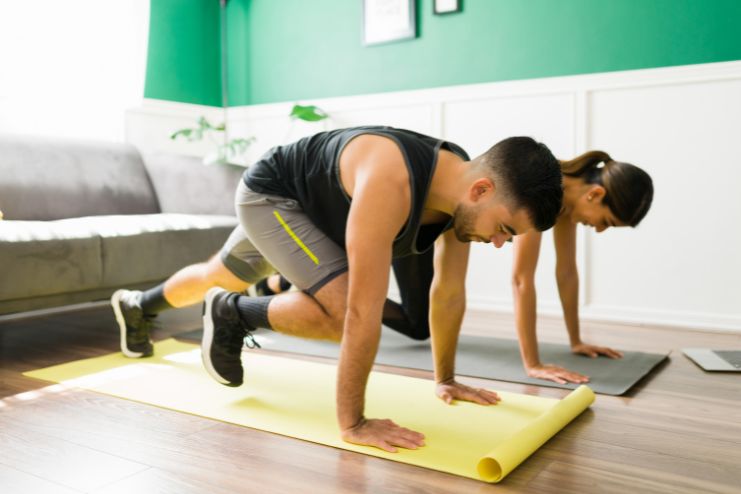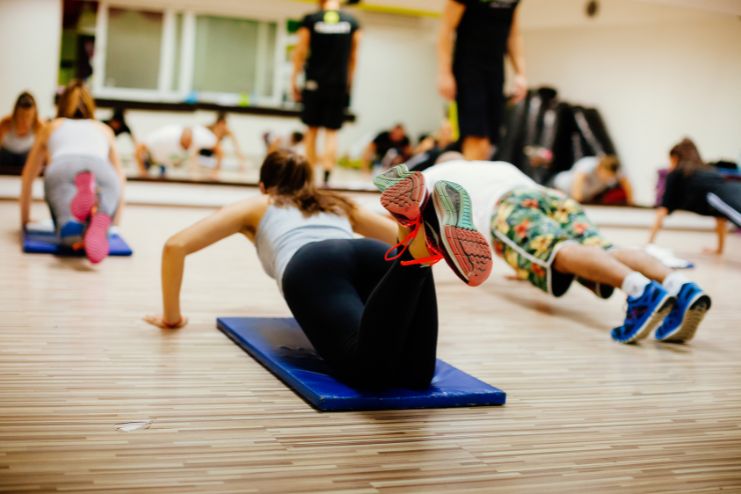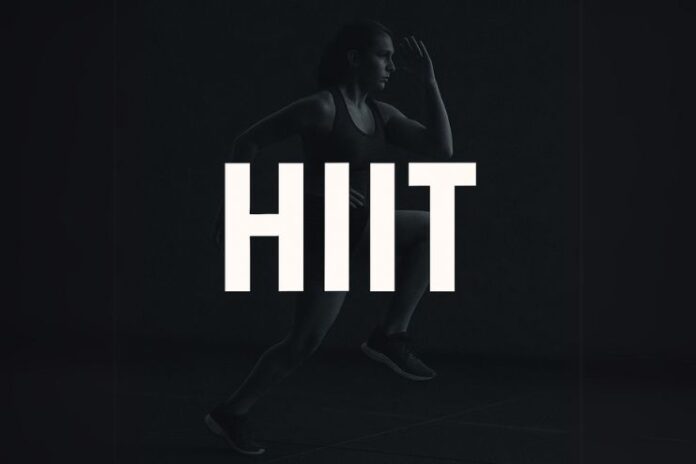In today’s fast-moving world, carving out time for exercise can feel like squeezing water from a stone. Finding a moment for fitness amid packed calendars and endless responsibilities is no easy task. The answer is High-Intensity Interval Training (HIIT), a potent, time-saving workout technique that maximizes benefits in the shortest time. HIIT is perfect for burning calories, increasing metabolism, and improving cardiovascular health without spending hours at the gym since it alternates short bursts of intense activity with short rest or low-intensity movement intervals.
Many people find it challenging to stick to regular exercise regimens because of lengthy workdays, family responsibilities, or general time restraints. Conventional exercises require more time than people with hectic schedules can devote. HIIT is a game-changer because it provides efficient workouts in as little as 15 to 30 minutes.
This article is crafted to guide and support you on your journey. Proper HIIT routines are simple to follow, effective, and ideal for your limited time, whether you’re a working professional, a busy parent, or someone constantly moving.
Read More: HIIT vs. Endurance Training: Choosing the Best for Your Fitness Goals
Understanding HIIT and its Benefits

High-intensity interval Training, or HIIT, can involve a wide variety of activities and is usually characterized by its structure.
One kind of interval training exercise is HIIT. It consists of many rounds that alternate brief intervals of lower-intensity movements with various minutes of high-intensity movements to raise the heart rate to around 80% of one’s maximum heart rate.
Sprint interval training is a more intense form of interval training that achieves 100% maximal heart rate. It was initially employed in the 1950s to help elite Olympic athletes perform better.
HIIT is a heart-healthy workout with several benefits. These are the main advantages of HIIT exercises supported by research.
- HIIT workouts have shown a greater ability to burn fat compared to traditional cardio routines that maintain a steady pace. According to this National Library of Medicine study, engaging in short bursts of high-intensity movement can increase your metabolic rate and the amount of energy your body burns for hours.
- VO₂ max, an aerobic endurance and fitness gauge, rises with HIIT. VO₂ max refers to the maximum level of oxygen your body can utilize as energy during intense physical activity. Regarding increasing VO₂ max, HIIT might be more beneficial than moderate, steady-state training.
- The interval training approach may improve blood pressure, one of several heart health indicators. In one study, a 6-week HIIT exercise program lowered older men’s blood pressure and improved their cardiovascular systems.
- Shedding extra pounds doesn’t mean sacrificing muscle. With HIIT, you can blend a variety of exercises that engage different muscle groups, helping you preserve—and even build—lean muscle while burning fat. This balanced approach supports weight loss without compromising strength.
- Benefits of regular exercise for the brain are well known. Research has demonstrated that HIIT enhances cognitive function. In a small study, researchers examined the effects of exercise on older persons’ memory. HIIT has proven to be more effective than both stretching and steady-state exercises when it comes to boosting memory.
- HIIT has been associated with improved mental health. People with physical and mental problems may experience less stress and depressive symptoms as a result of the training strategy.
Read More: How Exercise Snacking Can Help You Stay Fit Without a Gym
HIIT Workouts for Different Time Frames

You can do HIIT in many different ways. The goal of the workout is to push yourself to the limit during the active intervals, using the rest periods to recover and get ready for the next intense burst of exercise.
Tabata training is a well-liked HIIT model. It involves performing eight back-to-back rounds of 20-second intense effort, each followed by roughly 10 seconds of rest, totaling four minutes. That may not seem like much, but when you give maximum effort during each 20-second bout, you need just four minutes for an excellent workout!
Another 30:30 approach prescribes 6–10 minutes of high-intensity exercise followed by 30 seconds of lower-intensity exercise for active recovery. For instance, on a rowing machine, start with 5 minutes, which would be 5 to 30-second intervals, then work your way up from there. Alternate between 30 seconds of maximal effort and 30 seconds of low-intensity exercise for five minutes.
The third type, 30-20-10, arranges work intervals in increments of 60 seconds. This routine flows from 30 seconds of light effort to 20 seconds of moderate exertion, and then peaks with 10 seconds of intense, maximum-output movement. For a bodyweight variation, imagine holding a high plank for 30 seconds, transitioning into 20 seconds of controlled push-ups, and finishing strong with 10 seconds of rapid, explosive push-ups.
Tips for Success
- Always warm up for five minutes with dynamic stretches and light cardio before beginning.
- Drink lots of water, and please pay attention to your body.
- Wrap up every workout with a gentle cool-down and some stretching to support your body’s recovery and encourage muscle repair.
These HIIT exercises may be modified to fit your schedule and goals, whether you’re searching for a full-body challenge or a quick fitness fix. Even brief workouts can yield remarkable effects if done consistently and with effort.
Read More: 8 Fashionable Fitness Gear Must-Haves for Active Women
Maximizing Benefits and Safety Tips

If you want to maximize your workouts while remaining safe, it’s critical to approach each HIIT session with the appropriate mindset and preparation.
- Begin your session with about five minutes of light cardio, like jogging or jumping jacks, and then ease into dynamic stretches to prepare your muscles for the workout ahead. This helps reduce the risk of injury, enhances circulation, and primes your muscles for action.
- A cool-down, which involves stretching and light exercise to help your heart rate return to normal and reduce pain after a workout, is equally crucial.
- Proper form must be maintained for each movement to be effective and to prevent injuries. When pushing hard during brief bursts of activity, it’s easy to let proper form slip from focus. Move a little more slowly at the beginning, but take your time learning each exercise.
- It’s essential to move gradually, especially for beginners. Begin with shorter periods and less complicated versions of the exercises. Increase the number of rounds, duration, or intensity as your fitness level rises.
- Tune into your body’s signals and modify exercises when needed to suit your comfort and capability. Overexerting yourself too soon might result in burnout or injury.
- Don’t undervalue the importance of rest, food, and water in promoting your performance and recovery. Keep yourself hydrated by drinking water throughout your workout—before you begin, while you’re exercising, and once you’ve finished. Provide your body with nutrient-dense meals high in complex carbohydrates, protein, and good fats.
- Above all, get enough sleep and take some days off so your body can heal and strengthen.
Read More: Does Exercising Before Bed Ruin Your Sleep? Science Says It Depends
Conclusion
HIIT, or high-intensity interval training, offers a game-changing solution for those balancing hectic schedules. Its brief yet effective bursts of activity let you increase cardiovascular health, burn calories, and develop strength in a fraction of the time needed for more conventional workouts. There is an HIIT regimen to match your schedule and keep you on track, regardless of how much time you have—10, 20, or 30 minutes.
HIIT is the solution if you want to prioritize fitness without sacrificing your hectic schedule. Maintaining consistency, honoring your body’s limitations, and progressively pushing yourself over time is crucial.
Are you prepared to begin your HIIT adventure? Start now and observe the significant impact even a few minutes of concentrated work may have. We’d love to hear about your experiences and advancements, so please share them in the comments section!
References
- https://runrepeat.com/benefits-of-hiit
- https://nutritionsource.hsph.harvard.edu/high-intensity-interval-training/
- https://www.healthline.com/nutrition/benefits-of-hiit#benefits
- https://www.mayoclinic.org/medical-professionals/physical-medicine-rehabilitation/news/sprint-rest-repeat-exploring-the-benefits-of-high-intensity-interval-training/mac-20431116
- https://pubmed.ncbi.nlm.nih.gov/27747847/
- https://www.goodrx.com/well-being/movement-exercise/hiit-workouts-for-beginners
- https://www.menshealth.com/fitness/a25424850/best-hiit-exercises-workout/
- https://thebusinesstycoonmagazine.com/ultimate-hiit-workout-tips/
- https://coquitlamwellness.ca/hiit-injuries-prevention/
In this Article





















